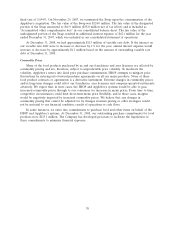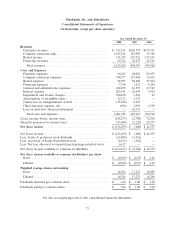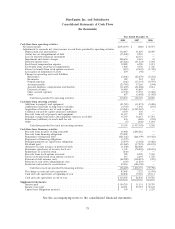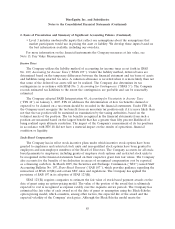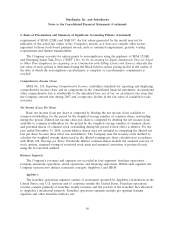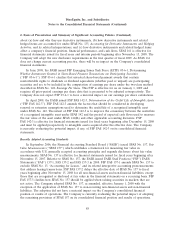IHOP 2008 Annual Report Download - page 92
Download and view the complete annual report
Please find page 92 of the 2008 IHOP annual report below. You can navigate through the pages in the report by either clicking on the pages listed below, or by using the keyword search tool below to find specific information within the annual report.DineEquity, Inc. and Subsidiaries
Notes to the Consolidated Financial Statements (Continued)
2. Basis of Presentation and Summary of Significant Accounting Policies (Continued)
Applebee’s franchisee receivables. As of December 31, 2008, Applebee’s franchisees operated 1,470
Applebee’s restaurants in the United States (which comprised 78% of the total Applebee’s restaurants
in the United States). Of those restaurants, the nine largest Applebee’s franchisees owned 765
restaurants, representing 52% of all franchised Applebee’s restaurants in the United States. Receivables
from all Applebee’s franchisees totaled $25.4 million at December 31, 2008.
The Company maintains an allowance for doubtful accounts based upon our historical experience.
Historically, such losses have been within management’s expectations
Cash and Cash Equivalents
The Company considers all highly liquid investment securities with remaining maturities at the date
of purchase of three months or less to be cash equivalents. These cash equivalents are stated at cost
which approximates market value.
Restricted Assets
Restricted Cash
The Company entered into three separate securitization transactions which resulted in the issuance
of a total of $2.3 billion in debt. The proceeds received from these transactions primarily were used to
fund the acquisition of Applebee’s. In addition, a portion of the proceeds was used to fund certain cash
accounts as required by the indenture and other related agreements (‘‘Securitization Agreements’’).
These cash accounts are to be used only for the purposes specified in the Securitization Agreements.
The Company has presented these cash accounts as restricted cash in both the current and non-current
asset sections of the consolidated balance sheets.
Other Restricted Assets
The Company has restricted assets related to its captive insurance subsidiary which are included in
non-current assets in the consolidated balance sheets. The captive insurance subsidiary was formed to
provide insurance coverage to Applebee’s and its franchisees. These restricted assets are primarily
auction rate securities and are restricted for the payment of insurance claims.
Investments
The Company has certificates of deposit that are included in short-term investments and auction
rate securities that are included in restricted assets related to the captive insurance subsidiary in its
consolidated balance sheets. The Company has classified all investments as available-for-sale with any
unrealized gain or loss included in Other Comprehensive Income. The contractual maturities of the
auction rate securities range from 2030 to 2033.
Inventories
Inventories consisting of food, beverages, merchandise and supplies are stated at the lower of cost
(on a first-in, first-out basis) or market. When necessary, the Company reserves for obsolescence and
shrinkage based upon inventory turnover trends, historical experience and the specific identification
method.
78




